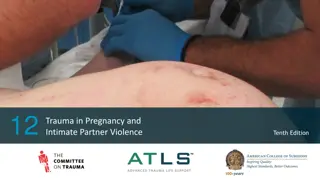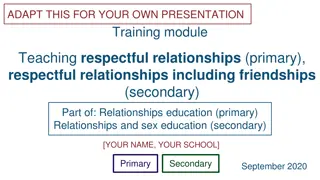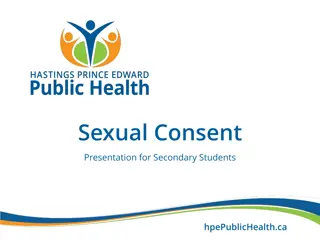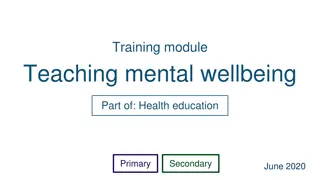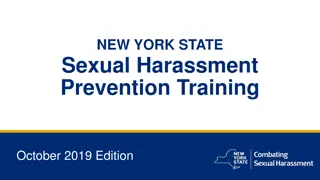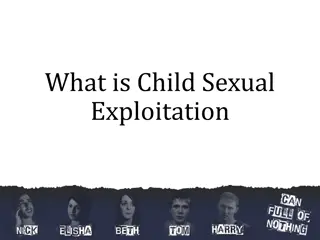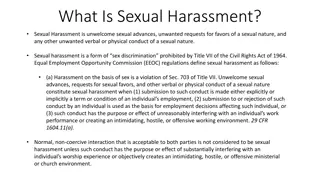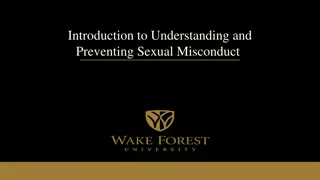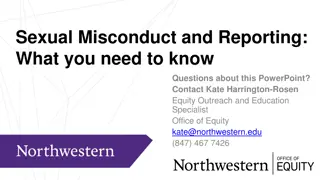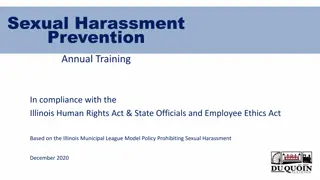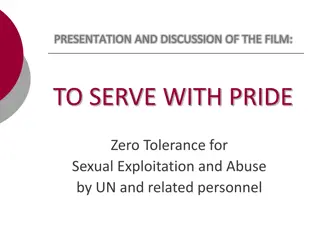Training Module on Intimate and Sexual Relationships in Secondary Schools
This training module on intimate and sexual relationships in secondary schools covers teaching strategies, safeguarding, and examples of good practice. It aims to enhance educators' confidence in addressing intimate relationships and sexual health, aligning with statutory guidance. The module emphasizes knowledge, facts, and strategies for effective classroom engagement. Related topics include respectful relationships, adolescent body changes, mental wellbeing, and prevention measures. School-specific healthcare support and policies are also outlined to provide a comprehensive approach to relationship and sex education.
Download Presentation

Please find below an Image/Link to download the presentation.
The content on the website is provided AS IS for your information and personal use only. It may not be sold, licensed, or shared on other websites without obtaining consent from the author.If you encounter any issues during the download, it is possible that the publisher has removed the file from their server.
You are allowed to download the files provided on this website for personal or commercial use, subject to the condition that they are used lawfully. All files are the property of their respective owners.
The content on the website is provided AS IS for your information and personal use only. It may not be sold, licensed, or shared on other websites without obtaining consent from the author.
E N D
Presentation Transcript
ADAPT THIS FOR YOUR OWN PRESENTATION Training module Teaching about intimate and sexual relationships, including sexual health Part of: Relationships and sex education [YOUR NAME, YOUR SCHOOL] Secondary September 2020
Contents 3 About this training module 5 Teaching the new curriculum 17 Safeguarding 19 Ground rules 22 Secondary curriculum 84 Examples of good practice 90 Activities and templates for trainers 2
About this training module Subject leads can use the adaptable slides and activities and templates for trainers section at the end of this module to help shape training sessions for teachers. This non-statutory training module supplements the statutory guidance on teaching about intimate and sexual relationships, including sexual health, which schools should read in full. Schools can choose whether and how to follow or adapt this training module and should refer to the Early Career Framework for pedagogical guidance. 3
What you get out of today By the end of this training you should: know what is included in the statutory guidance know some key knowledge and facts to cover as part of this topic have strategies to deal with questions that come up in class feel more confident teaching about intimate relationships and sexual health 4
Related topics Intimate and sexual relationships, including sexual health is closely related to the science curriculum as well as topics such as: respectful relationships, including friendships being safe changing adolescent body mental wellbeing health and prevention Therefore you should: consider thematic links across key topics and the whole school when planning and delivering lessons find ways to link knowledge and vocabulary across topics 6
RSE and healthcare support at [school name] Our leads [Names, contact details of child protection, wellbeing, pastoral, designated mental health leads] Our policies [Add details - e.g. school policy on PSHE, training opportunities] Specialist support [Add details - e.g. local authority, CAMHS, charities] Other information [Add resources] 7
RSE at [school name] Ways in which we already teach about and support relationships and sex education at our school: [add details] [add details] [add details] 8
Helping young people make healthy decisions From September 2020 schools must have regard to the new statutory guidance for teaching relationships and sex education, The guidance explains how this teaching will benefit pupils. STATUTORY GUIDANCE The aim of RSE is to give young people the information they need to help them develop healthy, nurturing relationships of all kinds, not just intimate relationships Knowledge about safer sex and sexual health remains important to ensure that young people are equipped to make safe, informed and healthy choices as they progress through adult life. (p25) 9
Progression from primary relationships teaching STATUTORY GUIDANCE RSE should provide clear progression from what is taught in primary school in Relationships Education. Teachers should build on the foundation of Relationships Education and, as pupils grow up, at the appropriate time extend teaching to include intimate relationships. (p25) Schools have flexibility to design and plan age-appropriate subject content based on the statutory guidance. Using your knowledge of your pupils and school community, you can decide when to introduce subject areas within the secondary phase. 10
Start with healthy intimate relationships Ground teaching in the characteristics of healthy relationships. When pupils have an understanding of what healthy looks like they will be better equipped to: establish and maintain good relationships recognise unacceptable behaviour in intimate relationships understand what they can do to protect their own and a partner s health in a sexual relationship know when and where to get help and advice if they need it 11
LGBT needs and inclusion Secondary schools should include LGBT content. Where LGBT content is included, schools should ensure teaching is inclusive of LGBT people and experiences. This should include: ensuring LGBT-relevant knowledge and examples are included throughout programmes of study (not one-off teaching) use of inclusive language, considering how individual pupils may relate to particular topics 12
Faith backgrounds All schools must ensure the faith/religious background of pupils are taken into account when planning teaching, so that topics are appropriately handled. STATUTORY GUIDANCE In all schools, when teaching these subjects, the religious background of all pupils must be taken into account when planning teaching, so that the topics that are included in the core content in this guidance [the statutory guidance] are appropriately handled. (p12) 13
Pupils with SEND You will need to plan lessons to allow all pupils to access and practise the core knowledge, using your expertise as you normally would. You might want to link lesson outcomes with statutory preparing for adulthood outcomes for those with an education, health and care (EHC) plan. (See SEND code of practice, section 8.) STATUTORY GUIDANCE In special schools and for some SEND pupils in mainstream schools there may be a need to tailor content and teaching to meet the specific needs of pupils at different developmental stages. As with all teaching for these subjects, schools should ensure that their teaching is sensitive, age-appropriate, developmentally appropriate and delivered with reference to the law. (p15) 14
Right to withdraw STATUTORY GUIDANCE Parents have the right to request that their child be withdrawn from some or all of sex education delivered as part of statutory RSE. (p18) This training does not cover the considerations you must take in relation to right to withdraw . Schools must refer to the following for full information: statutory guidance implementation guide 15
Teacher wellbeing The new curriculum covers a wide range of topics, some of which individual teachers might find personally challenging in different ways. It is important to feel you can ask for support or raise questions if: you have personal experience of a topic which makes teaching that content particularly challenging for you you have personal views on a topic that mean you need to discuss how you can ensure the teaching is delivered objectively Talk to your line manager, in the first instance, if you do need support. 16
Safeguarding 17
Safeguarding (1) Pupils may be affected by issues discussed in lessons. Let your designated safeguarding lead or deputy and any other relevant staff, such as pastoral leads, know what you are teaching. This will enable them to identify and speak to relevant pupils, especially those who they know may have been directly impacted by issues covered in the lessons and those with adverse childhood experiences. Teachers may need to deal with disclosures or concerns (e.g. of abuse or offending behaviour) in a way that safeguards pupils in line with school policies, especially the child protection policy. 18
Ground rules 19
Create class ground rules Clear class ground rules can help when teaching about sensitive topics. They also support confidentiality and safeguarding of pupils. Good practice is for ground rules to be: discussed and understood by all clear and practical modelled by the teacher followed consistently and enforced updated when needed visible in lessons (for example, posters) 20
Example ground rules Respect privacy. We can discuss examples but do not use names or descriptions that identify anyone, including ourselves. Listen to others. It is okay to disagree with each other, but we should listen properly before making assumptions or deciding how to respond. When disagreeing, challenge the statement not the person. No judgement. We can explore beliefs and misunderstandings about a topic without fear of being judged. Choose level of participation. Everyone has the right to choose not to answer a question or join discussion. We never put anyone on the spot (no personal questions or pressure to answer). 21
Intimate and sexual relationships, including sexual health 22
Subjects covered by these slides The content is divided into the following sections for ease of reference: healthy intimate relationships sexual consent and the law identifying and managing sexual pressure sexual relationships human fertility and reproduction pregnancy choices and support sexually transmitted infections (STIs) contraception and sexual health advice 23
Healthy intimate relationships STATUTORY GUIDANCE Know how to recognise the characteristics and positive aspects of healthy one-to- one intimate relationships, which include mutual respect, consent, loyalty, trust, shared interests and outlook, sex and friendship. Building on respectful relationships , teach pupils that the following characteristics contribute to healthy intimate relationships: friendship, shared interests and goals mutual respect and loyalty trust and consent Explain that intimate relationships, like other positive relationships (such as with friends, family), can support our mental wellbeing. Related topic: being safe (examples of unhealthy relationships). Secondary 25
Diversity of intimate relationships STATUTORY GUIDANCE Know how to recognise the characteristics and positive aspects of healthy one-to- one intimate relationships, which include mutual respect, consent, loyalty, trust, shared interests and outlook, sex and friendship. Teach that people are free to choose who they develop intimate one-to-one relationships with and that such relationships are diverse. Include reference to: same-sex / opposite-sex / non-binary relationships couples who share / have different cultural influences and beliefs committed relationships with or without a legal status (e.g. marriage, civil partnership, cohabiting) couples that do or do not have children Explain to pupils that not everyone is in a relationship. There is nothing unusual about this and many people choose to be single . Secondary 26
Good communication STATUTORY GUIDANCE Know how to recognise the characteristics and positive aspects of healthy one-to- one intimate relationships, which include mutual respect, consent, loyalty, trust, shared interests and outlook, sex and friendship. Teach that in a respectful relationship people should: feel able to express what they think and feel without being made to feel stupid or scared listen to and value the other person s views and feelings Honest communication is very important when people disagree (which is normal) or face challenges. It can be hard to talk about some issues but disagreements can often be resolved when people trust each other and talk issues through honestly and patiently. Secondary 27
Sex in intimate relationships STATUTORY GUIDANCE Know that they have a choice to delay sex or to enjoy intimacy without sex. Teach that couples can choose to delay sex or enjoy intimacy without sex. In a healthy relationship people can discuss how they feel about sex without feeling pressured, intimidated or ashamed. If someone is not ready to talk about sex that should also be respected. Teach that not everyone experiences sexual feelings. It is just as natural for someone not to experience sexual feelings as it is for someone else to have these feelings. Secondary 28
Choosing to not to have sex STATUTORY GUIDANCE Know that they have a choice to delay sex or to enjoy intimacy without sex. Teach that many people choose not to have sex, or to delay sex, for different reasons. This is sometimes referred to as abstinence . People do not need to explain or justify their reasons for not having sex and should not be pressured into changing their minds. Explain that deciding not to have sex with someone does not mean you do not love or care about them. Sex is not the only way people can be intimate or show love and affection. Secondary 29
Intimacy without sex STATUTORY GUIDANCE Know that they have a choice to delay sex or to enjoy intimacy without sex. Explain that there are many ways people can be intimate with their partner without sex such as: holding hands taking part in active hobbies together sharing experiences talking to your partner about how you feel about them Secondary 30
When relationships end STATUTORY GUIDANCE Know how to recognise the characteristics and positive aspects of healthy one-to- one intimate relationships, which include mutual respect, consent, loyalty, trust, shared interests and outlook, sex and friendship. Teach that relationships can end for different reasons. Everyone has the right to end a relationship and it doesn t have to mean the other person did anything wrong. Explain that: sometimes people give reasons for ending a relationship, but they do not have to breaking up can be difficult for both people if wellbeing is affected people can ask for support Explain that nobody has the right to harass or harm someone because they end a relationship. Related topic: being safe. Secondary 31
Sexual consent and the law You will also need to be aware of and, where needed, cover the content on consent included in the related module being safe . 32
UK legal age of consent (1) STATUTORY GUIDANCE Know how to recognise the characteristics and positive aspects of healthy one-to- one intimate relationships, which include mutual respect, consent, loyalty, trust, shared interests and outlook, sex and friendship. The age of sexual consent in the UK is 16. It applies to all people and sexual activity, regardless of gender or sexuality. The law aims to protect the rights and interests of children and young people. It also makes it easier to prosecute those who pressure/force others into sex. This content is also part of being safe. Secondary 33
UK legal age of consent (2) STATUTORY GUIDANCE Know how to recognise the characteristics and positive aspects of healthy one-to- one intimate relationships, which include mutual respect, consent, loyalty, trust, shared interests and outlook, sex and friendship. The law is clear that sexual activity with a child under 16 is an offence. It may be useful for teachers to be aware of the Home Office guidance on this area when approaching the issue. Consensual sexual activity between 2 people aged 16 or over is legal. This content is also part of being safe. Secondary 34
Freedom and capacity to consent STATUTORY GUIDANCE Know how to recognise the characteristics and positive aspects of healthy one-to- one intimate relationships, which include mutual respect, consent, loyalty, trust, shared interests and outlook, sex and friendship. In addition to being over the age of consent the law says that for there to be sexual consent both of the following must apply: the person seeking consent must have taken reasonable steps to gain that consent (e.g. asking whether someone agrees to what is happening both before and during sex) the other person must have freedom to consent (was free to say yes or no - voluntariness) and capacity to consent (being able to make decisions) This content is also part of being safe. Secondary 35
When consent is not possible STATUTORY GUIDANCE Know how to recognise the characteristics and positive aspects of healthy one-to- one intimate relationships, which include mutual respect, consent, loyalty, trust, shared interests and outlook, sex and friendship. Reflecting on the concepts of capacity and freedom , give examples of when consent is not possible, for example, if someone is: asleep or under the influence (lacks capacity) feeling threatened and feels unable to refuse (lacks freedom) Remind pupils that sexual activity with someone who does not have both capacity and freedom to consent is a criminal offence. This content is also part of being safe. Secondary 36
Checking for consent STATUTORY GUIDANCE Know how to recognise the characteristics and positive aspects of healthy one-to- one intimate relationships, which include mutual respect, consent, loyalty, trust, shared interests and outlook, sex and friendship. Teach that if someone doesn t say no , that is not the same as someone saying yes . If someone is unsure there is consent they must stop. If someone shows that they want someone to stop, e.g. by becoming very quiet or still, looking scared, or by saying/indicating no or stop , the other person must stop what they are doing or they will be breaking the law. This content is also part of being safe. Ensure pupils understand that people have the right to withdraw consent at any time, including during sex. Secondary 37
People in a position of trust STATUTORY GUIDANCE Know how to recognise the characteristics and positive aspects of healthy one-to- one intimate relationships, which include mutual respect, consent, loyalty, trust, shared interests and outlook, sex and friendship. Teach pupils that there is an extra legal protection for young people. It is against the law for a person aged 18 or over to have any sexual activity with a person under the age of 18 if the older person is in a position of trust (e.g. a doctor, care worker or teacher). This is because the influence that someone in this position has could affect the younger person s freedom and capacity to consent. This content is also part of being safe. Teacher reference: Sexual Offences Act 2003. Secondary 38
Sources of sexual pressure STATUTORY GUIDANCE Know that there are a range of strategies for identifying and managing sexual pressure, including understanding peer pressure, resisting pressure and not pressurising others. Teach pupils to identify sexual pressure in sexual decision-making, e.g. when people base decisions on: what others are doing (peers, celebrities, pornography) what others tell them to do (a partner, friends, social expectations) emotional/psychological pressure ( If you loved me you would do it ) Explain that pressure can be applied by individuals or by groups and that people are sometimes pressured differently, e.g. depending on their gender or sexuality (expectations based on stereotypes). Secondary 40
Recognising sexual pressure STATUTORY GUIDANCE Know that there are a range of strategies for identifying and managing sexual pressure, including understanding peer pressure, resisting pressure and not pressurising others. Explain that in a respectful relationship: positives (e.g. pleasure) are not used to pressure someone to have sex threats (e.g. of ending a relationship) are not used to bully or manipulate someone into having sex consent cannot not be assumed and is always necessary sex shouldn t be expected because people have had sex before consent to one type of sexual activity does not mean there is consent to other activities Secondary 41
Managing sexual pressure STATUTORY GUIDANCE Know that there are a range of strategies for identifying and managing sexual pressure, including understanding peer pressure, resisting pressure and not pressurising others. Teach that it is wrong, and sometimes illegal, for anyone (partner, boyfriend, girlfriend, anyone else) to sexually pressure or control someone else. Tell pupils that if this happens and someone needs help they can: speak to someone they trust at home or to a friend speak to a teacher or nurse at school contact ChildLine and speak anonymously about concerns Develop vocabulary, progressing from pressure to concepts such as coercion . Secondary 42
Not pressuring others STATUTORY GUIDANCE Know that there are a range of strategies for identifying and managing sexual pressure, including understanding peer pressure, resisting pressure and not pressurising others. Teach pupils to recognise when others are feeling pressured, and that people do not always resist by saying no . Other ways people may indicate that they do not consent include: delaying (saying not now , maybe later ) smiling/laughing, rather than answering directly trying to change the subject making excuses ( I can t , I m busy , I m tired ) minimising ( maybe , perhaps , sort of ) Remind pupils that consent should be a clear and freely given yes . Secondary 43
How sex can affect health STATUTORY GUIDANCE Know that all aspects of health can be affected by choices they make in sex and relationships, positively or negatively, e.g. physical, emotional, mental, sexual and reproductive health and wellbeing. Teach that sex can play a role in loving relationships between adults. Explain that choices people make about sex can positively and negatively affect physical, emotional, mental, sexual and reproductive health. Potential positives: intimacy, physical pleasure for themselves/partner a wanted pregnancy which can be fulfilling Potential negatives could include: someone regretting having sex when not ready getting a STI or having an unwanted pregnancy Secondary 45
Future sexual health STATUTORY GUIDANCE Know that all aspects of health can be affected by choices they make in sex and relationships, positively or negatively, e.g. physical, emotional, mental, sexual and reproductive health and wellbeing. Teach that there is a link between future sexual health and someone s first sexual experience. Future sexual health tends to be better when the following applies to a person s first experience of sex: 1. Willingness of both partners to have sex (both partners are able to and do consent). 2. Not reacting to peer pressure and not being under the influence of alcohol or drugs. 3. Using reliable contraception / protection against STIs. Secondary 46
Sexual health screening STATUTORY GUIDANCE Know that all aspects of health can be affected by choices they make in sex and relationships, positively or negatively, e.g. physical, emotional, mental, sexual and reproductive health and wellbeing. Teach that sexual health screening is a way for people to check if they have any STIs. This is a way for them to protect their own health and that of their partner. People can get tested through their GP or a sexual health clinic. Remind pupils that someone can have an STI without noticeable symptoms. Secondary 47
Alcohol, drugs and sex (1) STATUTORY GUIDANCE Know how the use of alcohol and drugs can lead to risky sexual behaviour. Teach that alcohol and drugs make it harder to make good decisions (including about sex). They can cloud thinking, lower inhibitions and lead to risky behaviour, such as: doing things you wouldn t choose to do when sober doing things you or a partner do not remember pressuring others in ways you wouldn t when sober (including pressuring others to get drunk or high, sexual pressure) unprotected sex (risk of pregnancy and STIs) Secondary 48
Alcohol, drugs and sex (2) STATUTORY GUIDANCE Know how the use of alcohol and drugs can lead to risky sexual behaviour. Expand on the increased risks associated with alcohol and drugs. For example, people can experience: painful emotions (regret, anxiety, paranoia) relationship problems (e.g. people being unfaithful to each other) physical injury to themselves or their partner Secondary 49


